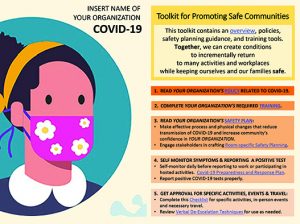Toolkit for COVID-19 Resources and Guidelines
The UW-Madison Division of Extension has undergone extensive research and implementation of health and safety guidelines to mitigate the risk of COVID-19 in our workplaces and in our educational programming events. We have incorporated guidance and research from the CDC, the Wisconsin Department of Health Services, and UW-Madison. Our tools and guidelines were developed for Extension’s needs. However, in response to requests from several partners across the state, Extension is making this toolkit available for modification by other organizations to address their planning and operational needs.
Index of Extension resources
We’re providing this set of tools for your use as an example. Although your set of tools will be different, they will likely include modified versions of each tool that together form a toolkit for your purposes. Where applicable, we’ve provided links for sources that informed our process and might further inform your planning.
In this toolkit you’ll find:
- A draft Diagram to help navigate your toolkit:

- Diagram: Toolkit for Promoting Safe Communities NOTE: Utilize this draft diagram and you can embed links to each of your documents and polices for easy access.
- Key tools prepared by Extension and provided as examples for your organization to modify:
- Policy: On-site workplace policy guide with decision prompts for working your way through rules and recommendations for staff.
- Training: Extension’s training videos with overviews of guidance and best practices to mitigate COVID-19.
- Safety Plan: A fillable safety plan you can make for your workplace.
- Room-specific Safety Planning: Worksheet for identifying strategies for different kinds of office environments.
- Infectious Disease Preparedness and Response Plan: Overview of symptoms for self-monitoring and what to do if you staff develops symptoms.
- Checklist: A fillable checklist of things to keep in mind when holding an event.
- Verbal De-escalation Techniques: Strategies and best practices for navigating difficult conversations and compliance.
Things to keep in mind
Explaining your guidelines is critical to creating understanding and compliance. Once you’ve developed your plans and are ready to roll them out, keep your audience in mind. What does your audience need to know and why is it important for them to follow the guidance you put in place? Communicate plainly and directly, making the connection between using the toolkit, the reduced spread of the virus, and thus the more likely continued health and well-being of themselves and their loved ones.
Some language to consider is:
- Compliance with state and local orders
- To be open for in-person operation right now, we want to make sure we’re not only following state and local policies, but also making sure everyone who comes through our doors feels comfortable doing so. To mitigate risk of the virus, we have guidelines in place based on best practices.
- Health promotes well being of people and economies
- In Wisconsin, we know people are at the heart of our economy. Wisconsin’s economy is more resilient when problem solving is done together. We can contribute to each other’s health and well-being, and therefore our economy/organization, with simple solutions like wearing a mask and practicing physical distancing of at least 6 feet, and using good personal hygiene. [credit: The Community Resilience and Response Task Force]
- We’re in this together
- We know the value of hard work, and taking on challenges is a way of life for us. We can find solutions that support our economy while keeping us healthy and safe. [credit: The Community Resilience and Response Task Force]
Call to action
We encourage you to take advantage of this base information to build your own toolkit. Developing an overarching diagram will help your user group understand how the tools are used as a set. Please invest your effort now.Together, we can create conditions to incrementally return to many activities and workplaces while keeping ourselves and our families safe.
Feedback
If you have questions or suggestions, please let us know.




